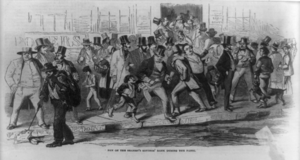
There have been as many as 48 recessions in the United States dating back to the Articles of Confederation, and although economists and historians dispute certain 19th-century recessions,[1] the consensus view among economists and historians is that "The cyclical volatility of GDP and unemployment was greater before the Great Depression than it has been since the end of World War II."[2] Cycles in the country's agricultural production, industrial production, consumption, business investment, and the health of the banking industry contribute to these declines. U.S. recessions have increasingly affected economies on a worldwide scale, especially as countries' economies become more intertwined.
The unofficial beginning and ending dates of recessions in the United States have been defined by the National Bureau of Economic Research (NBER), an American private nonprofit research organization. The NBER defines a recession as "a significant decline in economic activity spread across the economy, lasting more than two quarters which is 6 months, normally visible in real gross domestic product (GDP), real income, employment, industrial production, and wholesale-retail sales".[3][a]
In the 19th century, recessions frequently coincided with financial crises. Determining the occurrence of pre-20th-century recessions is more difficult due to the dearth of economic statistics, so scholars rely on historical accounts of economic activity, such as contemporary newspapers or business ledgers. Although the NBER does not date recessions before 1857, economists customarily extrapolate dates of U.S. recessions back to 1790 from business annals based on various contemporary descriptions. Their work is aided by historical patterns, in that recessions often follow external shocks to the economic system such as wars and variations in the weather affecting agriculture, as well as banking crises.[5]
Major modern economic statistics, such as unemployment and GDP, were not compiled on a regular and standardized basis until after World War II. The average duration of the 11 recessions between 1945 and 2001 is 10 months, compared to 18 months for recessions between 1919 and 1945, and 22 months for recessions from 1854 to 1919.[6] Because of the great changes in the economy over the centuries, it is difficult to compare the severity of modern recessions to early recessions.[7] Before the COVID-19 recession began in March 2020, no post-World War II era had come anywhere near the depth of the Great Depression, which lasted from 1929 until 1941 (which included a bull market between 1933 and 1937) and was caused by the 1929 crash of the stock market and other factors.
- ^ Cite error: The named reference
Zarn2126was invoked but never defined (see the help page). - ^ Whaples, Robert (March 1995). "Where Is There Consensus Among American Economic Historians? The Results of a Survey on Forty Propositions" (PDF). The Journal of Economic History. 55 (1): 139–154. doi:10.1017/S0022050700040602. JSTOR 2123771. S2CID 145691938.
The current consensus is that the volatility of GNP and unemployment were greater before the Great Depression than they have been since the end of World War II.
- ^ Hall, Robert (October 21, 2003). "The NBER's Recession Dating Procedure". National Bureau of Economic Research. Retrieved February 29, 2008.
- ^ "The NBER's Recession Dating Procedure: Frequently Asked Questions". National Bureau of Economic Research. Retrieved October 21, 2009.
- ^ Brent Moulton (December 10, 2003). "Comprehensive Revision of the National Income and Product Accounts 1929 through Second Quarter 2003". Bureau of Economic Analysis. Archived from the original on 2008-09-20. Retrieved February 29, 2008.
- ^ "NBER Business Cycle Expansions and Contractions". NBER. Retrieved October 1, 2008.
- ^ Moore, Geoffrey H.; Zarnowitz, Victor (1986). "Appendix A The Development and Role of the National Bureau of Economic Research's Business Cycle Chronologies". The American Business Cycle: Continuity and Change. University of Chicago Press. pp. 735–780. in Gordon 1986, pp. 743–745
Cite error: There are <ref group=lower-alpha> tags or {{efn}} templates on this page, but the references will not show without a {{reflist|group=lower-alpha}} template or {{notelist}} template (see the help page).
© MMXXIII Rich X Search. We shall prevail. All rights reserved. Rich X Search
